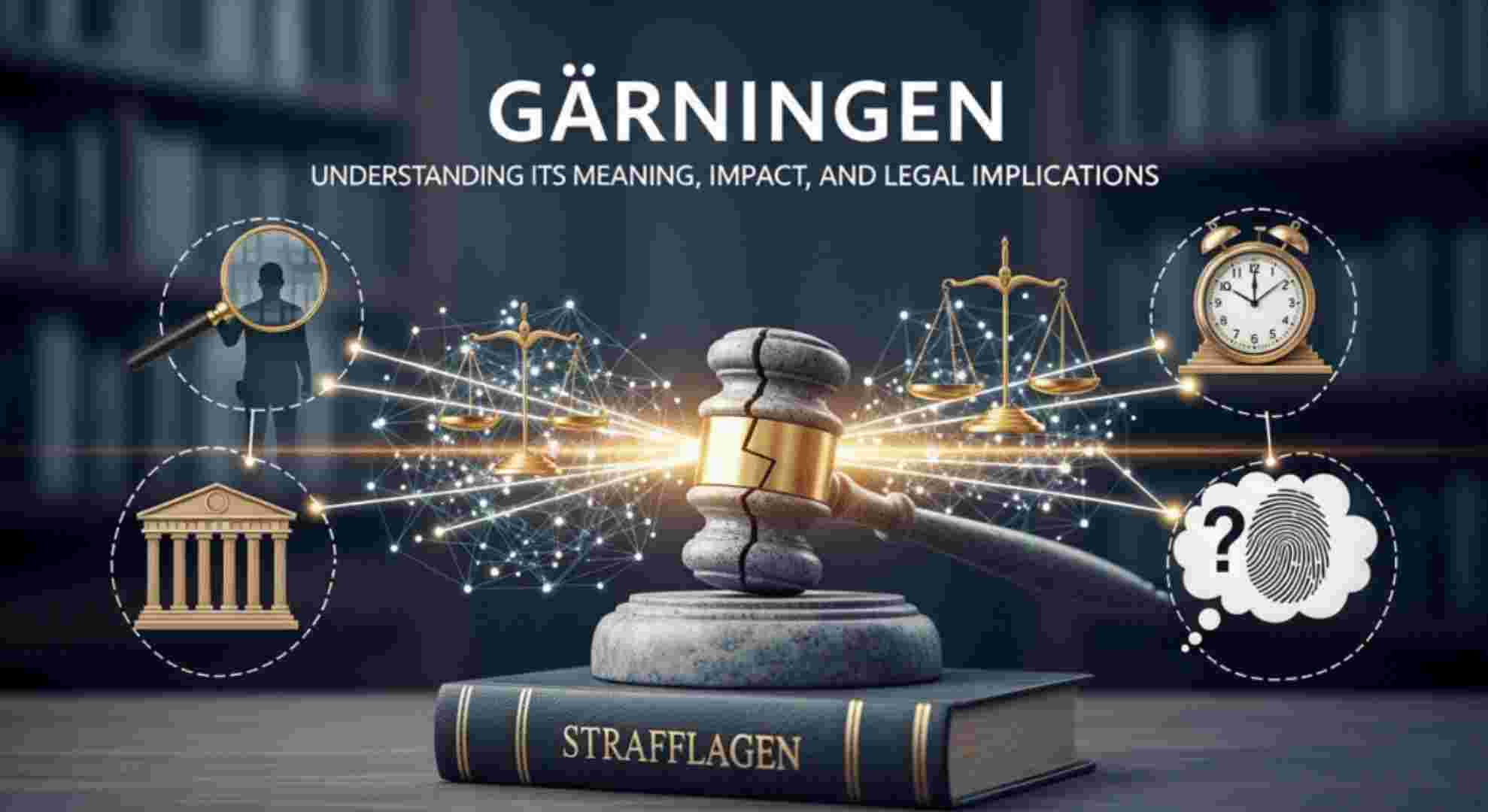
In Swedish culture and legal discourse, few words carry as much weight as “gärningen.” Though seemingly simple, this term captures a web of concepts ranging from moral responsibility to criminal accountability. Whether used in everyday language or courtroom proceedings, gärningen is a word that demands context, scrutiny, and often, consequence.
In this comprehensive guide, we’ll unpack the meaning of gärningen, trace its evolution in Swedish society, explore how it’s used in criminal justice systems, and look at the psychological and societal layers behind it. We’ll also demystify its role in current legal proceedings and offer real-life examples to help clarify how gärningen operates in practice.
What Does “Gärningen” Really Mean?
At its core, gärningen is the Swedish noun form of the word “act” or “deed.” But unlike the neutral “action,” gärningen often implies an act with consequences — moral, legal, or societal. It’s not just what was done, but how, why, and with what intent.
Linguistic Roots and Everyday Usage
In everyday Swedish, gärningen may be used to describe any notable action:
-
“Han hjälpte den gamla damen – en god gärning.”
(He helped the old lady – a good deed.)
But in legal or formal contexts, it usually refers to the criminal act — the focal point of an investigation or trial:
-
“Vad hände vid gärningen?”
(What happened during the act/crime?)
This dual usage means it carries both moral weight and legal precision, depending on context.
Legal Context: The Crime Itself
In Swedish criminal law, gärningen refers to the specific act committed by the accused. It’s the “event” under scrutiny:
-
Time and location
-
Method used
-
Motive and premeditation
-
Consequences (e.g., harm done)
Courts don’t just ask if a person committed a crime. They look deeply into the gärningen to establish intent (uppsåt), circumstance (omständigheter), and culpability (ansvar).
Gärningen in Swedish Law: A Deeper Dive
Let’s step into the courtroom. The term gärningen appears frequently in Swedish penal codes, police investigations, and court rulings. It is central to building a legal case, especially in crimes involving violence, fraud, or intent.
Elements of Gärningen
The legal system analyzes gärningen through a structured framework. Here’s how:
| Element | Description |
|---|---|
| Handling (Act) | The physical act itself — what was done? |
| Uppsåt (Intent) | Did the individual act knowingly or with willful intention? |
| Oaktamhet (Negligence) | Was the act due to carelessness or disregard for consequences? |
| Skada (Harm) | What damage or impact resulted from the gärningen? |
| Bevis (Evidence) | What supports the claim that this gärningen occurred as described? |
Case Example: Assault (Misshandel)
Imagine a case where a man punches another person outside a nightclub. The gärningen here isn’t just the punch — it’s the entire scenario:
-
Was it provoked?
-
Was it repeated?
-
Was the victim seriously injured?
-
Was a weapon used?
All of these factors shape how the gärningen is defined legally, and what sentence is handed down.
Psychological Dimension: Understanding Human Behavior Behind Gärningen
Understanding gärningen isn’t only about identifying the facts. It’s about diving into the psychological roots of behavior — something the Swedish justice system increasingly considers.
What Motivates the Act?
Modern criminology in Sweden looks at gärningen in light of:
-
Socioeconomic stress
-
Psychological disorders
-
Addiction
-
Traumatic past events
-
Peer pressure or gang affiliation
In fact, Swedish probation services often include a psychological evaluation of the gärningsman (perpetrator) to determine the risk of re-offending — and whether the gärningen was a one-time lapse or part of a deeper pattern.
Restorative Justice in Sweden
Sweden’s approach to justice often favors rehabilitation over retribution. Gärningen, in this context, becomes a turning point — a reference from which both victim and perpetrator can begin healing.
Societal Perceptions: How Swedes View “Gärningen”
In Swedish society, gärningen is often central to public discourse, especially in high-profile cases. But it’s not just the act — it’s about how society processes justice and accountability.
Media Coverage and Public Opinion
Major criminal cases like the assassination of Olof Palme or the recent gang violence surge are dissected in media with the gärningen as the narrative pivot. Swedish news coverage often asks:
-
“Vad var gärningen?”
-
“Hur kunde det ske?”
There’s a cultural tendency to search for logic behind irrational acts — a blend of pragmatism and humanitarian concern that defines Swedish values.
The Line Between Good and Bad Deeds
Interestingly, in Swedish culture, god gärning (a good deed) is held in equally high regard. Children are taught early on the value of att göra en god gärning — reinforcing moral conduct through language.
Thus, gärningen isn’t just about guilt — it’s about moral compass, an idea that permeates Scandinavian legal philosophy.
Gärningen in 2025: Shifts in Legal and Social Attitudes
As Sweden confronts new forms of crime — cybercrime, terrorism, and organized gang violence — the interpretation of gärningen continues to evolve.
Recent Legal Developments
In 2025, the Swedish Parliament passed reforms aimed at:
-
Strengthening penalties for crimes involving firearms
-
Broadening the legal definition of accomplices in gärningen
-
Allowing AI-assisted evidence review in criminal trials
All of these reflect a shifting landscape in how gärningen is established and prosecuted.
Digital Forensics and Gärningen
Now, the gärningen can include:
-
A hacked database
-
A threatening social media post
-
Cryptocurrency fraud
The crime scene isn’t always physical anymore — and Swedish law is adapting quickly.
Real-World Examples of Gärningen in Action
Example 1: The Knife Attack in Malmö (2024)
A man attacked a stranger in Malmö Centralstation. Surveillance footage and witness accounts helped the prosecution reconstruct the gärningen second by second. The intent (uppsåt) and use of a weapon made it a case of aggravated assault, resulting in a multi-year sentence.
Example 2: Insider Trading at a Tech Firm (2025)
A corporate employee leaked sensitive stock data. Though no physical violence occurred, the gärningen was considered economic sabotage, and the digital trail became critical in establishing guilt.
Summary: Why Gärningen Matters More Than Ever
To understand Swedish law, morality, and societal norms, you must understand gärningen. It’s more than a word — it’s a lens through which society examines behavior, intent, and justice.
Key Takeaways
-
Gärningen refers to an act or deed, especially one with legal or moral consequence.
-
In law, it encapsulates the who, what, when, and why of a criminal act.
-
It includes dimensions of intent, harm, and surrounding context.
-
Swedish society views gärningen as a moment of accountability, learning, and potential rehabilitation.
-
As crimes evolve, so does the legal understanding of gärningen.
Frequently Asked Questions (FAQ)
Q1: Is gärningen always a crime?
Not necessarily. While often used in criminal law, gärningen can also refer to good deeds or morally significant actions, such as charity or acts of bravery.
Q2: How do Swedish courts prove gärningen?
Through evidence, witness testimony, surveillance, forensic analysis, and psychological evaluations. The goal is to fully understand the event before assigning legal responsibility.
Q3: What’s the difference between gärningen and gärningsman?
Gärningen is the act; gärningsman is the person who committed the act. Think of the first as the crime and the second as the criminal.
Q4: Can gärningen be accidental?
Yes. Not all gärningar are intentional. In law, this introduces the concept of negligence (oaktsamhet), which still carries legal weight even without malice.
Q5: Has the digital age changed the meaning of gärningen?
Absolutely. Cybercrimes, online threats, and digital scams are now included in how courts define gärningen.
Q6: Why is gärningen so central to Swedish justice?
Because it focuses attention on the specific act rather than assumptions about character — ensuring that justice is measured, evidence-based, and fair.



